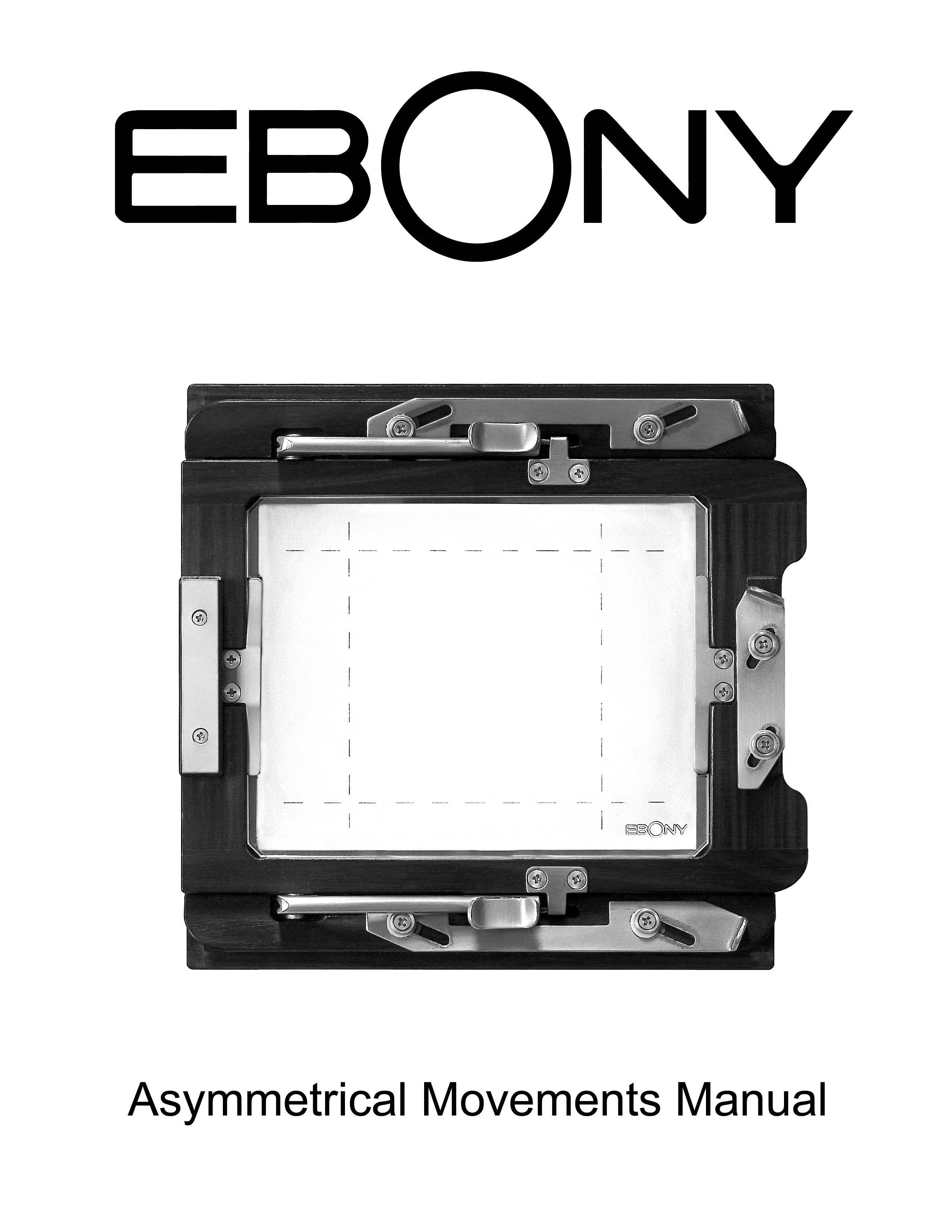Asymmetrical Camera Movements with Ebony U Model Cameras
Ebony cameras with a U in their model designation feature asymmetrical swing and tilt movements on the rear standard. This design facilitates quicker and more accurate implementation of certain types of camera movements. This manual provides a brief overview for the user detailing the general types of photographic situations where these movements may be utilized and a step-by step process for using asymmetrical movements with an Ebony camera.
In view camera photography, one of the most vital image controls is the ability to expand (or in some cases, contract) the degree of sharply focused detail within a composition through the use of swing and tilt movements. In a camera without movements, the range of sharp focus (depth-of-field) is controlled strictly through lens aperture and focal point. Large apertures have relatively narrow depth-of-field and smaller apertures have a much greater depth-of-field. The closer one focuses to the camera, the narrower depth-of-field becomes at any given aperture. There is inherently less sharp detail forward of the focal point (closer to the camera) than behind it (further from the camera). Hence, the rule of thumb is that to maximize depth-of-field, focus 1/3 of the way into the range of intended sharp detail and then stop down accordingly. But, with the view camera, photographers have the capability to actually re-align depth-of-field to a specific subject plane.
Understanding how these movements work requires familiarity with the Scheimpflug rule, which states that to obtain overall sharpness along a subject plane, the subject, lens, and film planes must either be parallel to one another or converge at a common point. For instance, in photographing a perspectival (oblique) view of the facade of a building, overall sharpness can be attained if the building's facade (the subject plane), the lens plane, and the film plane intersect at a common point. This can be accomplished by employing a swing on either the lens or film standard or a combination of both. Another example can be found in still life photography. Here, the primary subject plane is typically an arrangement of objects on a table surface. The camera is positioned above the table surface and angled down at the subject. In this example, a tilt is commonly employed so that the table surface (subject plane) converges with the lens and film planes at a common point. This is all rather straightforward and can be simply diagrammed to show convergence of the three planes. But, in real life shooting situations, how is the photographer supposed to know exactly how much movement is required to achieve convergence between subject, lens, and film plane? Asymmetrical movements provide a simple solution to determine the extent of movement.
Asymmetrical movements are perhaps best understood by way of comparison to the standard "symmetrical" movements common to most view camera designs. The symmetrical swings and tilts in a conventional view camera pivot on the two central axes of the film and lens planes: swings pivot on a centered vertical axis and tilts pivot on a centered horizontal axis. Alternatively, some cameras have base tilts in which the axis of movement is actually below the lens and film planes. Non-U Ebony folding models have both base and axis tilts on each standard. In all these varied tilt configurations, the swing movements remain symmetrical, i.e. the axis of movement is in the center of the optical axis and film plane.
When axis swings or tilts are employed on the rear standard of a view camera, the focused image becomes unfocused everywhere except at the axis of movement because the distance between lens and film remain constant only at this point. The photographer then has to refocus to see if the movement achieved its intended effect. (If you use base tilts, the entire image becomes unfocused because no part of the film plane maintains a constant distance to the lens.) Sometimes it may be necessary to go through the procedure of focusing, swinging/tilting, and then refocusing a few times before the desired effect of overall sharpness along the subject plane can be verified on the ground glass.
With asymmetrical movements, the intended effect of the movement can be seen immediately on the focusing screen because the axes of movement are not centered horizontally and vertically, but are instead off-axis or asymmetrical relative to the film plane. The concept for this approach is simple. Swings and tilts are most commonly utilized to extend the plane of sharpness from background (farther from the camera) to foreground (closer to the camera). Whether the composition is vertical or horizontal in orientation, background and foreground never fall compositionally on the film's vertical or horizontal axes for the same reason that left and right and top and bottom are never in the middle. By definition, background-foreground, left-right, and top-bottom are non-centered, non-axial points of reference. Swings and tilts that pivot off-axis to the vertical and horizontal center of the film plane are asymmetrical relative to these reference points, but they are actually symmetrical relative to the foreground and background areas of photographic compositions. The asymmetrical approach facilitates a precise process, executed in two discreet focusing steps, not a trial and error one that can involve several iterations.
The photographic examples in this manual were all taken with an Ebony 45SU. The technique is exactly the same with any Ebony U model. All Ebony U models feature a focusing screen marked with prominent horizontal and vertical lines that indicate to the photographer the asymmetrical axial pivots for swings and tilts on the rear standard. Swings pivot along the vertical dashed line to the left of the image center and tilts pivot along the horizontal dashed line below the image center. Focus remains constant at these axes as swings and tilts are employed. Note that these lines generally conform to foreground-background areas of horizontal and vertical compositions. This is the heart of the concept.
To utilize asymmetrical movements with an Ebony U camera: First, focus on that part of the subject falling along the line on the ground glass that identifies the axis of movement. Focus in the traditional way, using the focusing rail of the camera. It doesn’t matter whether the foreground or background of the composition falls along the axial line. The only critical factor is that preliminary focus is on the axis of movement because focus will be maintained on this line (or plane) when the movement (swing or tilt) is employed to bring the opposing side of the frame into focus. Then, with the focus rail locked into position, use the asymmetrical movement to focus the opposing side of the frame. Focus on the line opposite the initial focal point by swinging or tilting the rear standard until the subject comes into focus along this secondary line. Once this occurs, lock the standard. The movement has been set and its accuracy can be confirmed on the ground glass without refocusing.
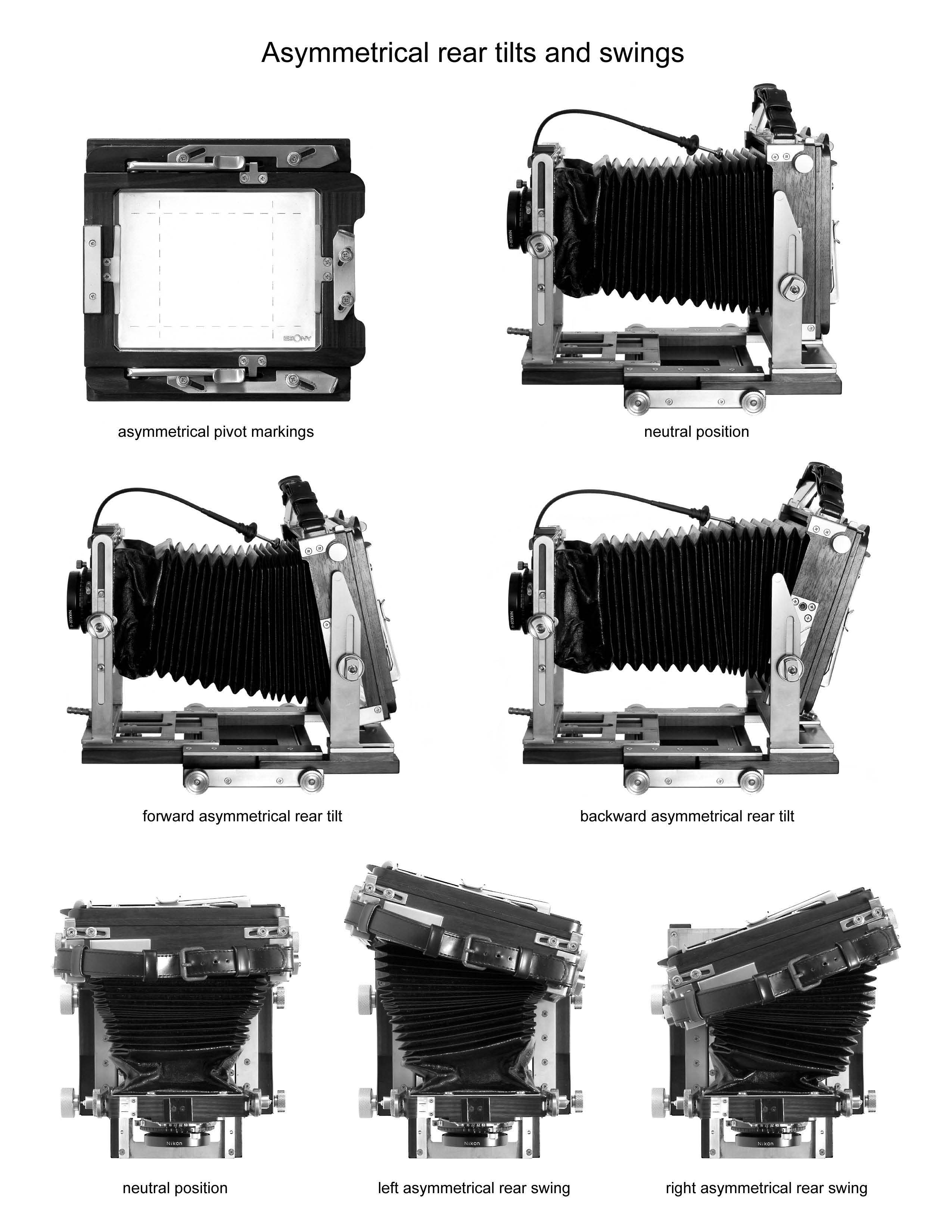
A couple of general guidelines to consider are that asymmetrical swing/tilt movements are typically used only when the camera position is at an oblique angle to the subject. The more oblique the angle, the more important the movement is to expanding depth of field. Secondarily, the subject must conform predominantly to a two dimensional plane. Angled views of a picket fence, the facade of a building, the surface of a table, a wall, etc. are all good examples of the types of subjects where swings and tilts may be employed to increase depth of field. Another important consideration is that as foreground or background is initially focused at the axis of movement, the subject detail along this line should be in approximately the same plane. If it isn’t, then the movement is not likely to re-align depth of field beyond what could be achieved by merely stopping down. Lastly, the marked axes of movement are only relevant for the primary format of the camera. If you use a reducing back, for roll film for example, then the lines that identify the axis of movement will not be accurate for the reduced format.
Following are some photographic examples where asymmetrical movements have been employed. These examples should make the concept of asymmetrical movements and their implementation very clear. The first two examples are from a famous New Orleans cemetery--St. Louis Cemetery No. 3, sometimes called the Bayou Cemetery, because of its proximity to Bayou St. John. This cemetery, like most others in New Orleans, is densely packed, and angled views of the long rows of tombs must be taken at close range to avoid obstructions. A depth-of-field from 4 feet (or less) from the camera virtually to infinity (in some cases) is required to render the subject in uniformly sharp focus. In the two photographs from St. Louis No. 3, identical apertures of f/11.5 were used. In one instance, no movement was applied. In the second instance, a swing was employed to extend the depth-of-field along the primary subject plane of the tomb facades. Once the movement has been applied, the depth-of-field is virtually infinite along the subject plane, in accordance with the Scheimpflug rule. In both instances, no guesswork is involved. The required amount of swing was implemented in a simple two-step focusing process using the lines on the focusing screen to establish the focal points.
The second example is an arranged still life titled "Cigar Box Memories." The opened box, which was found in a storage chest, is photographed on a marble tabletop with its inventory of old family snapshots placed around it. The camera is angled down to the subject. In this case, a tilt has been applied to the rear standard to enhance the primary subject plane of the inside lid of the cigar box down to the table surface forward of the box. In still life photography, because focusing distances are relatively close and lens focal lengths tend to be longer than normal (200mm, in this case), camera movements to extend depth-of-field are usually required to keep the entire subject in focus. As in the first two examples, identical images with the same lens and aperture (f/16.5) were taken. The first was taken with no movement employed, and the second with the necessary movement to extend depth-of-field so that the entire subject is in focus. As with the first two examples, a simple two-step focusing process quickly and easily established the degree of movement needed.
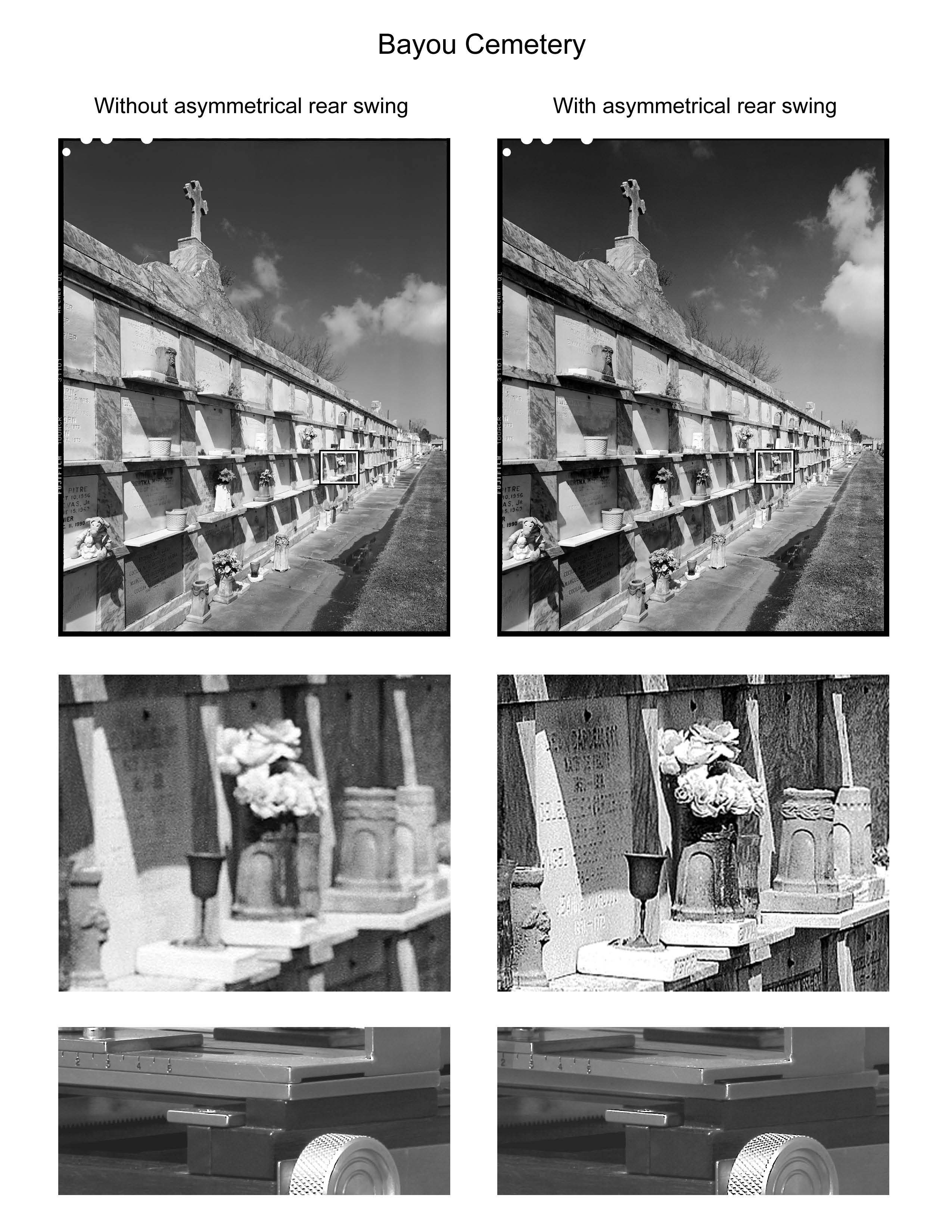
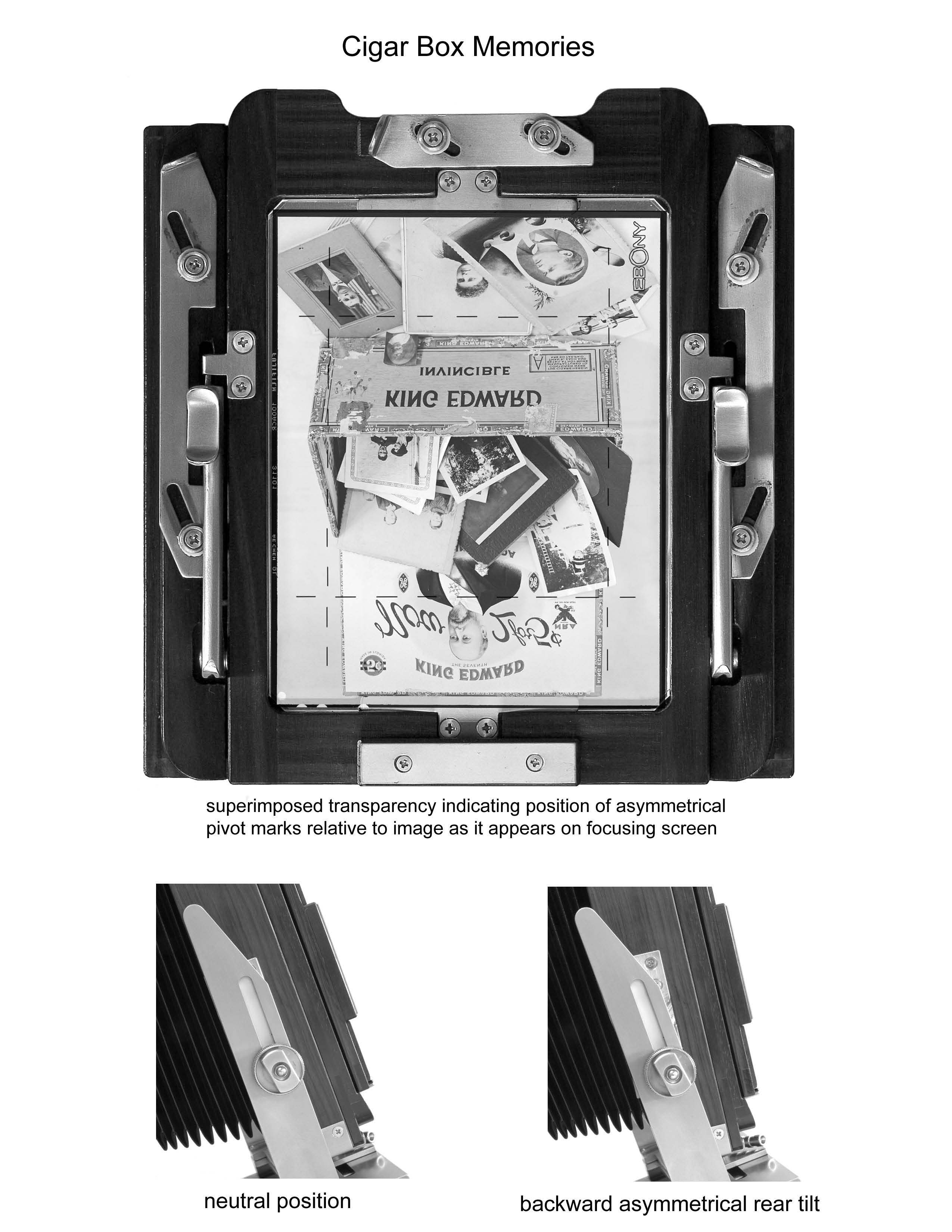

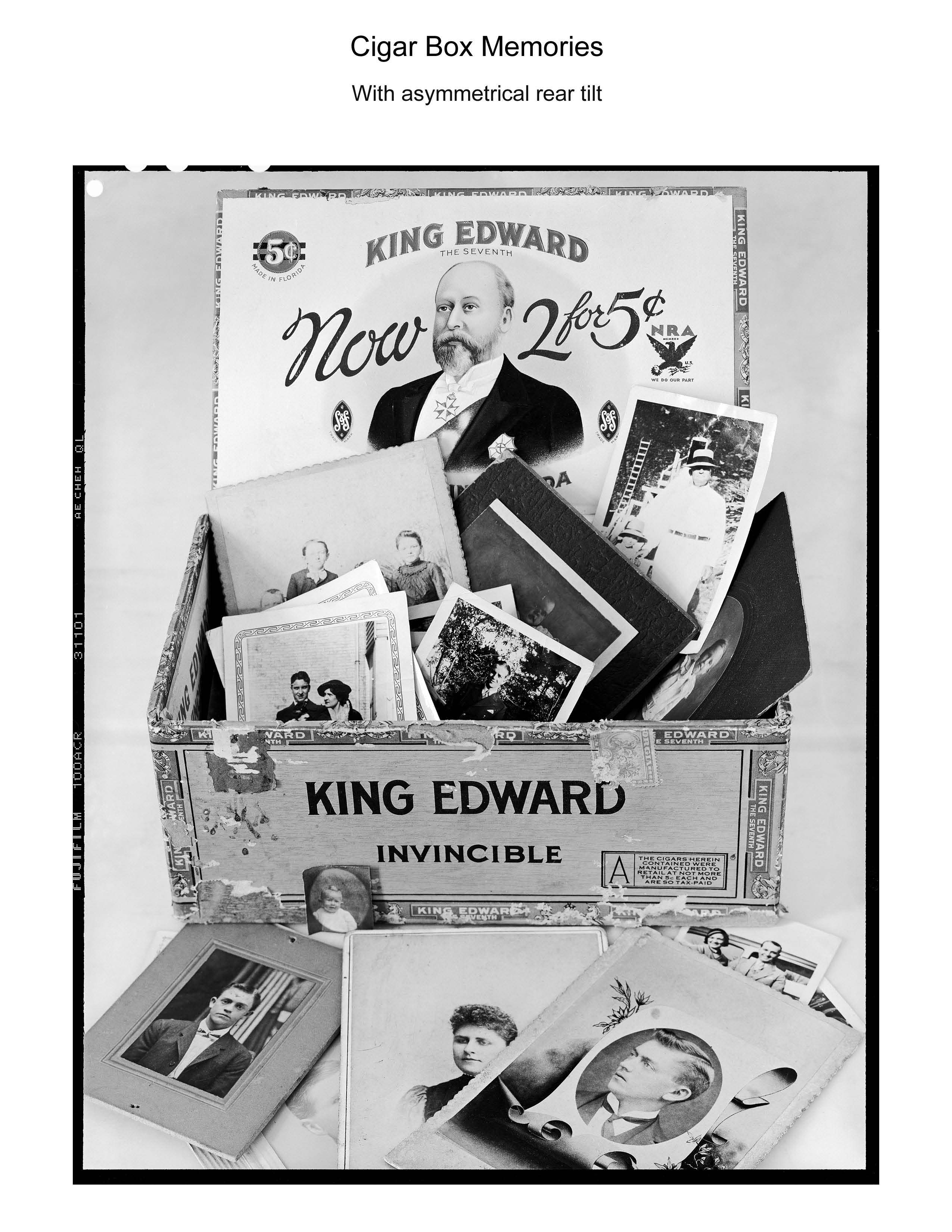
In both examples, relatively large apertures were used—f11.5 for the cemetery photos and f16.5 for the still life. There were two objectives for this. The first, of course, was to better illustrate just how effective camera movements are in extending depth-of-field. The second was to dispel the persistent myth that view camera lenses must be stopped down to their smallest apertures to perform optimally. Modern view camera lenses actually offer optimal performance near the center of their aperture range. Older, "classic" view camera lenses do need to be stopped down, but not the contemporary lens designs—all the more reason to utilize camera movements effectively so that an optimal aperture and optimal depth-of-field can both be attained.
In conclusion, it’s important to understand that rear swings and tilts affect perspective in a manner that front swings and tilts do not. Notice that the perspective is slightly different in all the examples when the rear swing and tilt movements were employed. When perspective control is important, then swings and tilts are best employed at the lens plane. The convenience of asymmetrical movements can still be utilized to determine the relative degree of movement required. These movements are then transferred to the lens standard, remembering that they must be reversed, i.e. in the opposite direction of the movements on the rear standard. After the movements have been transferred to the front standard, reset the rear standard to its detent (zero) position and refocus. When perspective control is not a primary issue, swings and tilts are best employed at the film plane. The reason is that when the lens is swung or tilted, the image circle projected by the lens is no longer a circle, but becomes oval-shaped relative to the film plane. The ovalling of the image circle reduces coverage and thus may limit the extent of lateral movements (shift or rise/fall) that can be utilized.
With a minimal amount of practice the use of asymmetrical movements should become quite intuitive and effortless. The purpose of this design feature is to make view camera photography with an Ebony easier and more efficient for the photographer.
RICHARD SEXTON
Richard Sexton is a noted author/photographer of photographically illustrated books on the subjects of architecture, design, lifestyle, and urbanism, including eight titles published by Chronicle Books, San Francisco. His commercial clients have included MTV, New Orleans Museum of Art, Peerless Lighting, Ralph Brennan Restaurant Group, Rosemary Beach Land Co., and Smith & Hawken. His work has been published in numerous magazines in the U. S. and Europe including Abitare, Landscape Architecture, Louisiana Cultural Vistas, Preservation, Smithsonian, and Southern Accents among many others. Sexton’s fine art photographs are included in the collections of New Orleans Museum of Art, The Ogden Museum of Southern Art, The Historic New Orleans Collection, and numerous private collections. In New Orleans, he is represented by A Gallery of Fine Photography. He teaches view camera and digital photography at the New Orleans Academy of Fine Arts. For additional information about Richard Sexton’s work, please visit his web site: www.richardsextonstudio.com ALL TEXT AND IMAGES © RICHARD SEXTON 2005
